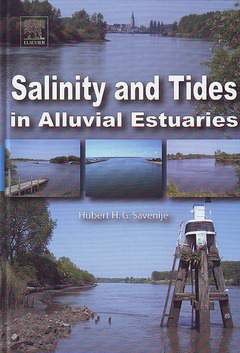Salinity and Tides in Alluvial Estuaries
Langue : Anglais

The book describes an integrated theory that links estuary shape to tidal hydraulics, tidal mixing and salt intrusion. The shape of an alluvial estuary is characterised by exponentially varying width and the absence of bottom slope. This topography is closely related to tidal parameters, hydraulic parameters and parameters that describe 1-dimensional mixing and salt intrusion. Starting from the fundamental equations for conservation of mass and momentum, analytical equations are derived that relate the topography to tidal parameters (tidal excursion, phase lag, tidal damping, tidal amplification), wave celerity, lateral and vertical mixing and salt intrusion. The book presents a review of the state of the art, a comprehensive theoretical background and ample case illustrations from all over the world. It provides tools with which human interference in estuary dynamics can be described and predicted, resulting from, for instance: upstream fresh water abstraction, dredging, climate change or sea-level rise. In describing the interactions between tide, topography, water quality and river discharge, it provides useful information for hydraulic engineers, morphologists, ecologists and people concerned with water quality in alluvial estuaries.Although the book can be used as a text book, it is mainly a monograph aimed at graduate students and researchers.
1. Description and classification of alluvial estuaries1.1 Importance of estuaries to mankind1.2 Classification of estuaries1.3 Estuary numbers1.4 Alluvial estuaries and their characteristics1.5 What will follow2. Tide and estuary shape:2.1 Basic hydraulic equations2.2 The shape of alluvial estuaries2.3 Relating tide to shape3. Tidal dynamics3.1 Tidal movement and amplification3.2 Tidal wave propagation3.3 The effect of river discharge and higher order effects on tidal damping3.4 The influence of climate change and human interference on estuaries4. Mixing in alluvial estuaries4.1 Types of mixing and their relative importance4.2 Gravitational circulation4.3 Mixing by the tide4.4 Residual circulation through ebb and flood channels4.5 The decomposition method4.6 Longitudinal effective dispersion4.7 Van den burgh's equation4.8 General equation for longitudinal dispersion5. Salt intrusion in alluvial estuaries5.1 Types of salt intrusion and typical shapes of salt intrusion curves5.2 Salt balance equations5.3 Influence of rainfall and evaporation5.4 Time scale and conditions for steady state5.5 Predictive model for steady state 5.6 Unsteady state model5.7 Hyper-saline estuaries5.8 Concluding remarks
Ecologists, morphologists, hydraulic engineers
* Provides new integrated theory for tidal hydraulics, tidal mixing and salt intrusion in alluvial estuaries* Presents a consistent set of analytical equations to compute tidal movement, tidal mixing and salt intrusion, derived from the fundamental laws of conservation of mass and momentum* Serves as a practical guide with many illustrations of applications in real estuaries
Date de parution : 12-2005
Ouvrage de 208 p.
Thèmes de Salinity and Tides in Alluvial Estuaries :
© 2024 LAVOISIER S.A.S.



